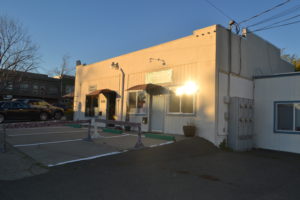
Applicant Gordon Wong is part of a team proposing to turn the building at 800 First St. and its adjacent parcel into a new 2 1/2 story retail and residential development. The Historic Preservation Review Commission provided suggestions to Wong at its Thursday meeting. (Photo by Nick Sestanovich)
A proposed mixed-use development at the corner of First and East H streets drew much scrutiny at Thursday’s Historic Preservation Review Commission meeting.
Campbell-based firm GKW Architects is proposing to redevelop the building at 800 First St. with a new multi-use development consisting of 2,924 square feet of retail on the ground floor and nine residential units on the upper floor. The building in question includes 800 First St. and the adjoining vacant parcel. The site once housed a gas station and now rents out five tenants: Spotless Carpet Cleaning, Anh’s Salon, Bayside Vintage Living & Design, In Harmony Music and Old Capitol Locksmith.
Principal Planner Suzanne Thorsen said the proposal is only in the pre-planning stage, and applicant Gordon Wong was there that evening to gather feedback. If the application is approved, the building would have to be demolished and the two existing parcels merged into one.
Wong said the building would retain the original facade and parapet walls. The top floor would consist of two-bedroom residential rental units, and the bottom would be largely retail, possibly coffee shops or crepe restaurants. The building would also have a flat metal roof, a porch and dining area in the front, recessed entryways, screened parking facilities, window planter boxes and balconies to match the building across the street. Wong said his team took a lot of inspiration from other downtown buildings.
“Our team really wanted to make the correct steps to make sure we got the appropriate design, something that really enhances the downtown strip of Benicia,” he said.
Commissioner Gilbert von Studnitz asked what the current need for the project was.
“It’s exceptionally hard for someone in my generation to get a mortgage loan,” Wong said. “My wife and I went through the same exact thing to get that first job, try to find a mortgage on a house. Now if you have a two-bedroom unit, that is within a range for an upcoming professional to afford that kind of unit and have the best of both worlds to go down, grab a cup of coffee, do their errands and not have to drive so much.”
“We want to support our local professionals, local people who need to get into their first home mortgage,” he added.
Jerry Hayes, a former mayor who operates Camellia Tea Room with his wife on the same block, delivered a little history of the site. The 800 block was once home to the Palace Hotel, a 2 1/2 to 3-story structure which burned down in 1932. A service station operated at the corner, which was abandoned in the ‘50s or ‘60s and gave way to its current use as a rental unit for various businesses.
Hayes expressed mixed feelings about the design element and losing a historic building but supported the notion of boosting the downtown.
“I have a deep interest in whatever we can do to enhance our Downtown Historic District,” he said. “Certainly when changes come along in a proposal like this, it’s really important that we do our best to get it right and try to sustain that historic ambiance and enhance it in some way.”
Julie Chiodo, who has operated Bayside Vintage Living in the space for 14 years, acknowledged that the current building lacks “curb appeal” but expressed disappointment that the landlord never disclosed any information to her or the other tenants on the project.
“I think they should have talked about our visions as businesses, and if want to be an occupant in this building and what those rents are going to entail,” she said.
Chiodo said one of her main concerns was being able to afford rent in other spots on First Street.
“It is sad to think us five businesses will no longer exist whenever this process begins,” she said.
Local historian Donnell Rubay was appreciative of the fact that property owners were taking cues from other downtown buildings for their design but noted that the building across the street— which provided the basis for the balconies on the proposed design—is not a truly historic building but rather a “guess” as to what historic buildings looked like.
“You’re kind of copying what was already a guess,” she said.
Rubay’s main concern was the potential precedent that demolishing the 800 First St. building would set.
“Every single piece of property in this town that has a historic building on it could benefit their owner considerably in the same way that these people wanna be benefited by building a much larger building on that property,” she said. “Once you tear down one building, you have opened the door for more.”
“We’re going to put a knife into the heart of the historic district because we will have set a precedent,” she added.
The commissioners made a couple of design recommendations for Wong’s team including celebrating and reusing historical elements, smaller units for current tenants, conducting a facade study of neighboring facades, consider the heights of the balconies and looking into trash enclosures. Wong was open to most of the suggestions.
“We’re not here to fight any historical elements,” he said. “We’re here to understand the criteria of what we’re trying to get to make this a very, very substantial part of Benicia downtown.”
The City Council would have ultimate authority over approving the project, Thorsen said.
In other matters, the commission reviewed a status update on Downtown Historic District Design Guidelines.
The commission will next meet on Thursday, March 22.






Leave a Reply